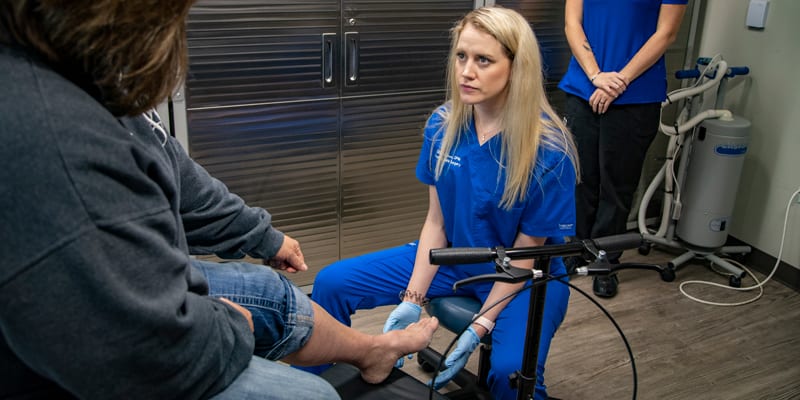Plantar fasciitis is a common foot condition that affects many people each year. At Foot and Ankle Surgeons of Oklahoma, we're here to help you understand and manage this painful condition. Let's look at what plantar fasciitis is, how it's treated, and ways to prevent it.
Key Takeaways
- Plantar fasciitis is the most common cause of heel pain
- Symptoms include sharp, stabbing pain in the heel, especially in the morning
- Most cases can be treated without surgery
- Treatment options include stretching, orthotics, and physical therapy
- Prevention involves proper footwear and gradual increase in activity
What is Plantar Fasciitis?
Understanding Plantar Fascia
Plantar fasciitis happens when the thick band of tissue that connects your heel to your toes (called the plantar fascia) gets inflamed. This can cause a sharp, stabbing pain in your heel, especially when you take your first steps in the morning.

Plantar fasciitis is the most common cause of heel pain, with about 2 million patients treated annually. The good news is that most people get better within 10 months with proper treatment.
Key Facts About Plantar Fasciitis
- Most common cause of heel pain
- 2 million patients treated annually
- Typical recovery time: 10 months with proper treatment
- Primary symptom: Sharp, stabbing heel pain
- Pain occurs with first steps in the morning or after sitting
Understanding the Causes and Symptoms
Common Causes of Plantar Fasciitis
Plantar fasciitis can happen for many reasons. Sometimes it's because you're on your feet a lot, or you've suddenly increased your exercise. Other times, it might be due to the shape of your foot or tight calf muscles. The main symptom is heel pain, especially when you first get out of bed or after sitting for a long time.
If you're experiencing heel pain, it's important to get it checked out. At Foot and Ankle Surgeons of Oklahoma, we offer expert diagnosis of heel pain conditions. We'll examine your foot, ask about your symptoms, and might even use imaging tests to rule out other problems.
Risk Factors for Plantar Fasciitis
Who is at Risk?
While plantar fasciitis can affect anyone, certain factors can increase your risk:
- Age: It's most common between the ages of 40 and 60
- Certain types of exercise: Activities that put a lot of stress on your heel and attached tissue, such as long-distance running, ballet dancing, and aerobic dance
- Foot mechanics: Flat feet, a high arch, or an abnormal pattern of walking can affect how weight is distributed when you're standing and put added stress on the plantar fascia
- Obesity: Excess weight puts extra stress on your plantar fascia
- Occupations that keep you on your feet: Factory workers, teachers, and others who spend most of their work hours walking or standing on hard surfaces can damage their plantar fascia
Non-Surgical Treatment Options
Conservative Treatments for Plantar Fasciitis
The good news is that most cases of plantar fasciitis can be treated without surgery. Here are some common treatments we recommend:
- Rest and ice: Give your feet a break and use ice to reduce inflammation.
- Stretching exercises: Gentle stretches can help loosen tight muscles and fascia.
- Supportive footwear: Wear shoes that provide good arch support.
- Custom orthotics: These special inserts can help distribute pressure more evenly across your foot.
- Night splints: These keep your plantar fascia stretched while you sleep.
- Over-the-counter pain medications: These can help manage pain and inflammation.

At Foot and Ankle Surgeons of Oklahoma, we offer personalized orthotic solutions for plantar fasciitis. Custom orthotics can make a big difference in managing your pain and preventing future problems.

Advanced Non-Surgical Treatments
When Standard Treatments Aren't Enough
If simpler treatments aren't helping, we might suggest some more advanced options:
- Physical therapy: A therapist can teach you exercises to strengthen your feet and legs.
- Steroid injections: These can provide quick relief from inflammation.
- Shockwave therapy: This treatment uses sound waves to stimulate healing.
- Platelet-rich plasma injections: This uses your own blood cells to accelerate healing in the affected area.
Our team at Foot and Ankle Surgeons of Oklahoma offers cutting-edge treatments for persistent plantar fasciitis. We're always looking for the best ways to help our patients feel better.
Surgical Options for Plantar Fasciitis
When Surgery is Necessary
Surgery is rarely needed for plantar fasciitis, but it's an option if other treatments haven't worked after 6-12 months. The most common surgery involves releasing part of the plantar fascia from the heel bone. This can be done through a small incision or sometimes with a special tool that doesn't require an incision.

If surgery is needed, we'll guide you through the process and help with your recovery. Most people can start putting weight on their foot about 2-3 weeks after surgery, but full recovery can take several months.
Preventing Plantar Fasciitis
Simple Steps for Prevention
Prevention is always better than cure. Here are some tips to help prevent plantar fasciitis:
- Wear shoes with good arch support and cushioning.
- Replace your shoes regularly, especially if you're a runner.
- Stretch your feet and calves regularly, especially before exercise.
- Maintain a healthy weight to reduce stress on your feet.
- Increase your activity level gradually to avoid sudden strain on your feet.
- Mix high-impact activities with low-impact ones to reduce stress on your feet.
- Use proper technique during sports and exercise to avoid foot strain.
For more tips on preventing foot and ankle conditions, check out our foot health education resources.
Living with Plantar Fasciitis
Managing the Condition
Living with plantar fasciitis can be challenging, but there are ways to manage the pain and stay active. Here are some tips:
- Use a cold pack on your heel after activity to reduce pain and swelling.
- Wear supportive shoes even when you're at home.
- Try low-impact exercises like swimming or cycling instead of running.
- Do gentle stretches for your feet and calves throughout the day.
- Consider using a standing desk or anti-fatigue mat if you stand for long periods at work.
- Practice good foot hygiene and keep your feet moisturized to prevent cracks and fissures.

Remember, most people with plantar fasciitis get better within a year. Stay patient and consistent with your treatment, and you'll likely see improvement.
When to Seek Professional Help
When to Consult a Doctor
While many cases of plantar fasciitis can be managed at home, there are times when you should see a doctor. Consider making an appointment if:
- Your heel pain doesn't improve after a few weeks of home treatment.
- Your pain is severe or suddenly gets much worse.
- Your heel is hot and red, or you have a fever.
- You have diabetes and are experiencing heel pain.
- You experience numbness or tingling in your foot.
- You have difficulty putting weight on your foot.
At Foot and Ankle Surgeons of Oklahoma, we offer expert consultation services for plantar fasciitis and other foot conditions. Our team is here to help you get back on your feet.

Conclusion: Key Takeaways for Managing Plantar Fasciitis
Seek Early Diagnosis
Consult a specialist if heel pain persists or worsens.
Non-Surgical Options First
Explore conservative treatments before considering surgery.
Consider Custom Orthotics
Custom-made inserts can provide targeted support.
Maintain Consistent Treatment
Follow your treatment plan consistently for best results.
If you're struggling with heel pain, don't wait to get help. Contact Foot and Ankle Surgeons of Oklahoma today for personalized plantar fasciitis treatment. Our experienced team is ready to help you take the first step towards pain-free feet.
